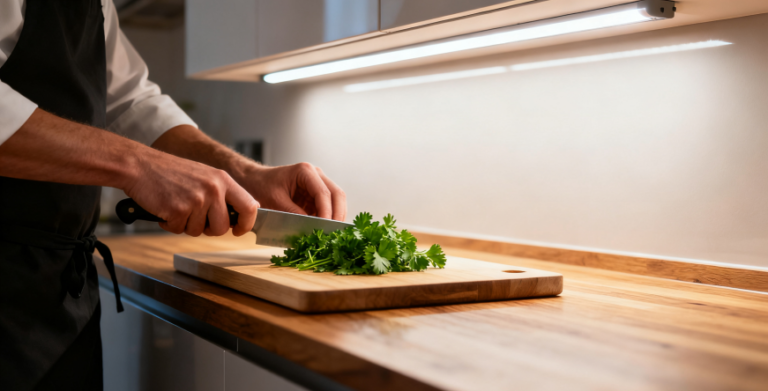
Picking the right under-cabinet lighting can feel like a challenge, but trust me—it’s easier than it sounds!
The right under-cabinet lighting can transform your space, enhancing both function and ambiance.
With a few practical guidelines, you'll soon be selecting the ideal lighting setup for your needs. Let’s dig into the essentials.
What Kind of Under-Cabinet Lighting Should I Use?
There are so many options—LED strips, puck lights, bar lights—each brings its own unique feel. So, how do you choose?
For general lighting, go with LED strips; for focused areas, puck lights work well.

Exploring Different Lighting Options
Each type of lighting has its charm. LED strip lights are sleek and adaptable, perfect for kitchens and workshops where continuous light is key. They run along the underside of cabinets, creating a smooth, unbroken light that’s easy on the eyes and perfect for task-heavy spaces. Plus, they’re straightforward to install, which is always a win. For example, I’ve seen designers create wonderful effects by matching LED strip color temperatures with backsplash materials to pull the entire space together.
Puck lights, on the other hand, are compact and versatile—ideal for small spaces or focused lighting areas. Imagine them as little “spotlights” on your countertop, which is great for prepping and chopping. And bar lights? They’re sturdy, evenly spread the light, and work well for longer cabinets if you need consistent illumination across the entire length.
| Lighting Type | Best For | Features |
|---|---|---|
| LED Strips | Smooth, even light coverage | Sleek, adaptable, easy installation |
| Puck Lights | Focused spot lighting | Compact, great for accents |
| Bar Lights | Long, even lighting strips | Sturdy, works well for continuous areas |
Consider the mood and functionality you’re after, then pick the type that best fits your setup!
How Do You Layout Under Cabinet Lights?
Positioning your under-cabinet lights can make or break your design. So, where exactly should they go?
Place lights near the cabinet front edge for best coverage and reduced shadows.

Planning a Practical Lighting Layout
If you want evenly distributed light, place your lights near the cabinet’s front edge rather than at the back. This arrangement helps prevent pesky shadows while cooking or working, a small tweak with a big impact. A layout rule of thumb for puck and bar lights: install them about 8-12 inches apart. That way, you’ll avoid creating “hot spots” (overly bright areas) while maintaining a uniform look.
But it’s not just about spacing. Look at how your counter space and cabinet structure are arranged. If you’re using LED strips, measure each cabinet’s length, and run a continuous strip light to avoid gaps. A well-planned layout maximizes both functionality and aesthetics, especially if you combine it with a dimmer switch. The ability to adjust brightness instantly brings versatility to your kitchen or workspace.
How to Measure for Under-Cabinet Lighting?
Grab your tape measure! A few simple measurements can go a long way in helping you make the right lighting choice.
Measure the cabinet length, depth, and any wiring space needed for a seamless fit.

Measurement Tips for a Seamless Installation
Start by measuring the total length of the cabinet underside where you want the light to go. LED strips work well when they’re close to the full length of the cabinet, providing even coverage. Be mindful of depth too—shallow cabinets might benefit more from puck lights due to their focused nature.
If you’re planning on hardwiring the lights, be sure to include measurements for wiring space. Or, if you’re using plug-in options, check for a nearby outlet. Also, consider if the light needs to fit around any edges or cabinet trims. With LED strips, you can usually trim them to fit perfectly, but bar and puck lights may have stricter length requirements, so you’ll want to keep those exact measurements handy.
How Many Under Cabinet LED Lights Do I Need?
Wondering if one strip or a couple of pucks will do the job? It’s all about balancing light output with your cabinet space.
Typically, install one LED light or puck every 8-12 inches to cover the cabinet length.

Balancing Light Quantity with Space Needs
Let’s say you have a stretch of cabinet that’s four feet long. You’d generally need around four puck lights (one per foot) to get that consistent, even lighting across the length. Or, if you’re opting for an LED strip, just make sure it spans as much of the cabinet as possible to avoid dark spots. LED strips usually allow for easy adjustment in brightness and length, giving you extra flexibility in both setup and final appearance.
Consider lumen output as well. Kitchens and workspaces generally need more brightness than, say, ambient lighting for a living room bar setup. If your project calls for extra light, choose lights with higher lumens, or consider installing an additional row of lights for greater coverage. You’ll end up with a space that feels bright, balanced, and just right for every task.
Conclusion
Choosing under-cabinet lighting is simpler with clear goals. With the right planning, your setup will be both functional and stylish.
Visit EVERBRITE for lighting solutions that elevate any space.



